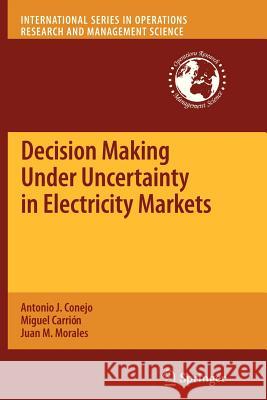Decision Making Under Uncertainty in Electricity Markets » książka
Decision Making Under Uncertainty in Electricity Markets
ISBN-13: 9781461426783 / Angielski / Miękka / 2012 / 542 str.
Decision Making Under Uncertainty in Electricity Markets
ISBN-13: 9781461426783 / Angielski / Miękka / 2012 / 542 str.
(netto: 1152,86 VAT: 5%)
Najniższa cena z 30 dni: 1156,64
ok. 22 dni roboczych.
Darmowa dostawa!
This addition to the ISOR series is a readable yet rigorous advanced text/reference on models and decision-making under uncertainty in the growing area of electricity markets. It is the first book to show how to use stochastic programming procedures to carry out in-depth analysis of decision-making models under uncertainty in these markets, including formulation issues and solution techniques. Due to the recent creation of futures markets for electricity in the past decade, much of the book is groundbreaking and reflects the most recent advances in operations research and its application in energy markets in general. An electricity market is simply a system for effecting the purchase and sale of electricity using supply and demand to set the price. These markets are competitive, and have been a growing worldwide trend since the 1980's, and coming to prominence (and notoriety) in 2001 when both the California electricity crisis and the Enron scandal occurred. Though the phenomenon of the electricity market grew from deregulation, and will likely continue to move toward increased openness, the situation in California resulted entirely from faulty regulation, particularly in modeling risk. The fact is, there are so many constraints to consider in modeling these markets, with so many possible points of failure, that it's a wonder it's taken this long for a rigorous text on stochastic programming to appear. This is an advanced expository book on solving the most current and relevant short- and medium-term decision-making problems pertaining to producers, consumers, retailers, and market operators. Among its unique features: it addresses essentially all operational problems that arise in electricity markets; practical applications are developed up to the stage of working algorithms, coded in the GAMS (General Algebraic Modeling System) so that practitioners can put the book to use immediately; applications encompass areas in applied mathematics and business, as well as electrical and energy engineering; it presents a unified treatment of risk; it includes two chapters on wind power; and it provides an appropriate blend of theoretical background and practical applications. It can be used in graduate level courses (or Conejo's own PhD course in electricity markets) in a broad range of programs, whether economic, mathematic, or engineering, and will also be well-suited for the practitioner.











